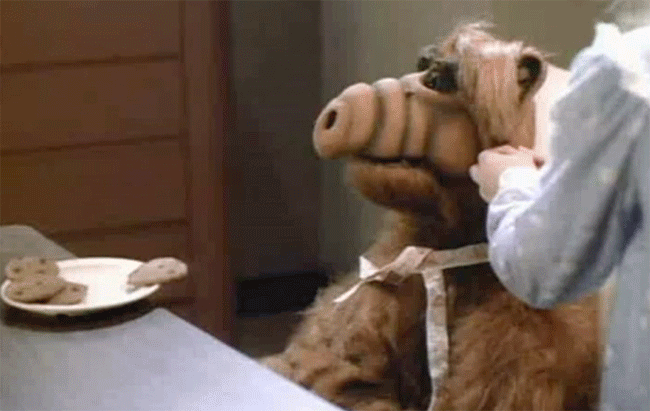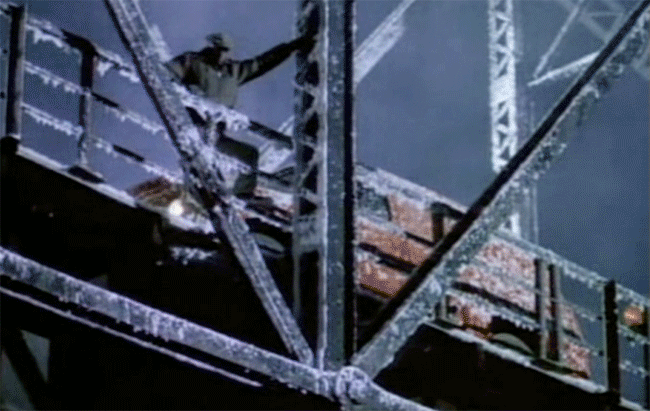The heartbreaking true story behind 'ALF's Special Christmas'

The ’80s were a heyday for “Very Special Episodes,” those odd installments of a family sitcom and/or kids’ show where things unexpectedly got serious. Whether it was Alex P. Keaton spending an entire episode in therapy or Arnold Jackson having a harrowing encounter with a child molester, these half-hours admirably, if often awkwardly, tried to address complex subjects in ways that young viewers could process. At that time and still today, there’s never been a “Very Special Episode” quite like “ALF’s Special Christmas.” Premiering precisely 30 years ago on Dec. 14, 1987, ALF‘s hourlong Christmas tale separated the titular intergalactic immigrant from his adopted human family so that he could bring good tidings and joy to a dying young girl named Tiffany as she prepares to celebrate her very last holiday. Oh yeah, and he also prevents the hospital’s resident Santa, Mr. Foley — who is a grieving widower when not in costume — from taking a leap off of a snowy bridge.
It’s safe to say that dying children and suicidal Santas aren’t conventional ways of spreading Christmas cheer. And in the years since “ALF’s Special Christmas” premiered, the episode has frequently been written about in disbelieving tones by writers who are flummoxed by how it ever aired in the first place. Now the story can be told: Yes, Virginia, there really was a Tiffany. Yahoo Entertainment learned this bombshell bit of news when we spoke with Paul Fusco, who created and voiced ALF, and writer Steve Hollander, who penned “Alf’s Special Christmas.” “The episode came out of a true story,” Fusco reveals. “I used to do a lot of Make-A-Wish things, because kids would write to ALF and I would get calls from doctors. It’s heartbreaking when you think about it.”

One of the letters he received was from a girl named Tiffany Leigh Smith, whom the character in “ALF’s Special Christmas” is based on. “I don’t remember all the details, but I saved her letters and have them on file,” Fusco says. As Hollander recalls, the real Tiffany was a 9-year-old from the Midwest suffering from leukemia and eager to have a face-to-face conversation with her favorite Melmac citizen. “Someone at the local NBC station arranged a kind of video conference setup between her in her hospital bed and ALF,” he says. “He also had the presence of mind to turn on the tape and record it! [Former NBC president] Brandon Tartikoff saw it and thought, ‘We should make a Christmas special around this story.'”
While he can’t recall the specifics of his conversation with Tiffany, Fusco says that his general approach to those kinds of private appearances would be to keep the mood light and playful. “I would make jokes and small talk. I would try not to talk about their situation, which they didn’t want to talk about anyway. I would sometimes get a fact sheet about what they liked or didn’t like. And then I’d throw it to them, and ask, ‘Do you have any questions you want to ask me?’ I tried to make them laugh as much as I could and then say, ‘Hang in there, you be good — I hope to see you again.’ You leave them on a positive note; it’s about all you can do.” One rule he absolutely had was to never break character in front of the children. “These kids wanted to believe — it was magic to them. I was a magician early on in my career, and you never want to see what’s behind the curtain. You want to keep it real.”
That’s the same way that Hollander and Fusco both approached the task of turning Tiffany’s real-life story into the basis for “ALF’s Special Christmas.” Watching the episode, it’s striking how different it looks from a typical episode of ALF or, for that matter, a typical episode of any ’80s sitcom. Gone is the traditional rhythm of setup and punchline, as well as the show’s usual set and three-camera setup, replaced by a single camera (the episode was shot on film, rather than video), real locations — including a former hospital rented out by film and television productions — and a pronounced emphasis on emotional moments. The dramatic shift is evident from the earliest scenes, when ALF’s misunderstandings of Christmas conventions lead him to exile himself from the Tanner clan, climbing into Mr. Foley’s van and ending up in the pile of presents he hands out to sick kids at the hospital. “I was unsure of how it would come off,” Fusco admits now of the special’s more serious tone. “I didn’t want it to look hokey or saccharine in any way. I was also worried how I would react in those scenes, but it was really one of the first dramatic roles that ALF had to play in the show.”

In contrast, Hollander says that once he viewed the tape of ALF’s bedside chat with Tiffany and talked at length with the show’s co-creator, Tom Patchett, the story flowed easily. “In Tom’s mind, the central question for ALF was: What do you say to a little girl who is not going to see another Christmas?” Perhaps recognizing the unique tonal and narrative challenges presented by that question, Patchett allowed Hollander to pen his script outside of the writers’ room, where episodes were written and rewritten by the entire staff. “The staff was not involved in outlining the story or rewriting it. The person who could change anything was Tom.” And Hollander remembers that Patchett didn’t want to change very much about the script that he turned in. “Maybe 10-15 percent was cut out just for time. There was one scene in the beginning where the Tanners are driving to their family cabin, and ALF is in the backseat in a child’s seat with a little steering wheel. And every two seconds, he’s going, “Are we there yet? Are we there yet?’ That didn’t get filmed because of production scheduling. But other than that, nothing major was taken out or added.”
One scene that was always in the script, much to Fusco’s concern, was a sequence where ALF would play doctor to a pregnant woman, helping deliver her baby while they were both stranded in an elevator. Hollander wrote that encounter into the script as a way to generate some laughs in an otherwise serious episode. “I was kind of on edge about that scene,” Fusco confesses now. “Any time they could put ALF in a doctor’s suit or something stupid like that, I was always like, ‘No, no, no, no!’ But they said, ‘You need to balance the jokes off with the dying child.’ It’s probably the silliest moment in the episode, but I think the audience forgave us.”

As per “Very Special Episode” tradition, “ALF’s Special Christmas” features a pair of very special guest stars. Blazing Saddles leading man Cleavon Little personally sought out the role of Mr. Foley, a character Fusco says he hoped veteran character actor Barnard Hughes might play. “Our casting person said that Cleavon was either a fan of the show or made some overture that he was interested in the part. I thought, ‘Wow, that’s a total 180 from where I was going with it!’ I don’t think he started out as a comedic actor and, because of Blazing Saddles, he probably wanted a dramatic role again. He was a fun guy to work with.”
And Fusco couldn’t resist injecting a little Blazing Saddles-style humor into his relatively few scenes with Little. While shooting the bridge sequence, where ALF talks Mr. Foley back from the literal ledge, the actor went off-script for the first take. “I yelled ‘Jump,’ and then said, ‘You’ve got nothing left; you might as well do it — it’s the right choice.’ The crew went crazy! I think that broke the ice with Cleavon.” (It’s worth noting that Little also shares scenes with another future star, Carl Franklin, who plays Tiffany’s doctor. Franklin has since become a respected director, alternating features like Devil in a Blue Dress with episodic work on shows like House of Cards and The Leftovers.)

For the role of Tiffany, meanwhile, NBC indulged in a little cross-promotion by suggesting that the producers cast child actress Keri Houlihan, one of the stars of the Wilford Brimley drama Our House. Fusco says he’s uncertain whether Houlihan — who left acting after Our House ended in 1988 — was aware that she was playing a real person. But neither she nor NBC insisted on providing the fictional Tiffany with a last-minute reprieve via, say, a Melmacian serum or a Christmas miracle. The last time we see her, she’s sadly waving goodbye to ALF from the window of her hospital room, a clear signal that she won’t be going home. (A closing title card pays tribute to the real Tiffany.) “That never came up — maybe because there was a real story there,” Hollander says when asked whether the network wanted a happier ending. “Nobody thought, ‘We’ve got to make a cheerful Christmas story. It was a true situation; we weren’t trying to invent a story.” In fact, Fusco remembers receiving letters from Tiffany’s mother and doctor after the girl’s death. “They said that by just allowing her to talk to ALF, it prolonged her life by maybe a month. It gave her hope to hold on to.”
While “ALF’s Special Christmas” is often met with baffled reactions today, 30 years ago it helped the sitcom attain its perch among 1987’s most highly rated shows. And rather than be upset by it, young viewers seemed to take its serious storyline in stride. “The phone was ringing off the hook for sponsors as soon as that episode aired,” remembers Hollander, who went on to work as a co-producer during the show’s third season and also wrote a two-part Thanksgiving special where ALF aids a homeless man in the Tanners’ neighborhood. “My mother watched the show with some young kids from the neighborhood and said, ‘They didn’t laugh once!’ And I said, ‘That’s great, Mom. That’s just what I wanted.’ It was a true situation and we had this character that kids didn’t know was just a puppet. ALF had meaning to a lot of children.”

Fusco expresses similar sentiments about kids’ affection for his alien alter ego blunting any emotional trauma from Tiffany’s story. “They believed enough in the character that we were able to pull it off and keep it real. They saw the emotion and felt that ALF had more range than just being a one-line jokester.” At the same time, he’s aware that “ALF’s Special Christmas” is more of a time capsule for a vanished era of TV as opposed to a source of inspiration for contemporary sitcoms. “What shows are doing that kind of thing today? The Big Bang Theory wouldn’t do something like that. Did we overdo it back then? Or is it because there’s so much horror in the world right now, we want to give audiences pure escapism? Buying into the character was the important part, and it apparently worked because people are moved by it.”
ALF is available to rent or purchase on Amazon, or stream for free on Amazon Prime with a Starz subscription.
Read more from Yahoo Entertainment:
The 30 best TV moments of 2017
Celebrities who lit up 2017
All of ‘The Office’ Christmas episodes, ranked

